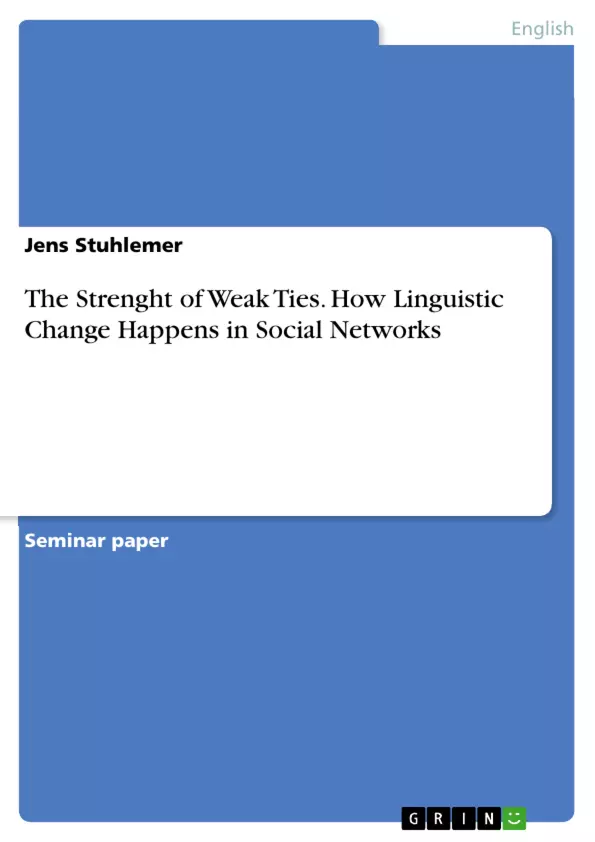The following pages will take a deeper look on the Social Network Theory as part of the sociolinguistics. It will further be discussed, to what extend social networks are bound to concepts of social class. Since the Social Network Theory was primarily build to function as tool within the sociolinguistics, a short summary of two studies will be discussed. Furthermore, oppositions and similarities of Milroy´s and Labov´s theories according to main factors of linguistic change shall be shown. A historical perspective of weak ties will be given at the example of late medieval and early modern London, before the last chapter will not only try to summarize the most important results, but also hint at the importance of an integrated model of the network theory and social factors.
Inhaltsverzeichnis (Table of Contents)
- Introduction
- The Concept of Social Network
- Relationship, social class & social network
- Social network as a tool in the sociolinguistics
- Labov's approach
- Network as a reaction to Labov
- Weak ties in late medieval and early modern London
- Conclusions towards an integrated model
Zielsetzung und Themenschwerpunkte (Objectives and Key Themes)
This text examines the Social Network Theory (SNT) within the field of sociolinguistics, exploring its relationship with concepts of social class. The text delves into the strengths and weaknesses of different approaches to the SNT, such as Labov's and Milroy's theories, with particular attention given to the role of weak ties in linguistic change. It also analyzes how social networks can function as tools within sociolinguistics and the influence of broader social frameworks on their structure.
- The role of social networks in linguistic change
- The relationship between social class and social networks
- The influence of weak ties on language variation and innovation
- The importance of an integrated model that considers both social networks and broader social factors
- The application of SNT in understanding language variation and change across different communities and historical periods
Zusammenfassung der Kapitel (Chapter Summaries)
- Introduction: This chapter provides an overview of the text's focus on the SNT and its application in sociolinguistics. It highlights the key themes of social class, linguistic change, and the influence of weak ties.
- The Concept of Social Network: This chapter defines the SNT, explaining the concept of social contacts and the different types of ties within a network. It explores Granovetter's concept of weak ties and their role as linguistic bridges, contrasting them with strong ties and their influence on information exchange.
- Relationship, social class & social network: This chapter delves into the relationship between social class and social networks, exploring how class structures can influence network formation and linguistic variation. It discusses Milroy's theory of class stratification and its impact on network structure and the role of weak ties in maintaining or resisting linguistic change within different social classes.
- Social network as a tool in the sociolinguistics: This chapter examines the SNT's application as a tool in sociolinguistics, focusing on the central question of how and why linguistic change occurs within specific languages and communities. It emphasizes the importance of understanding the dynamics of networks and the role of weak ties in facilitating linguistic innovation.
Schlüsselwörter (Keywords)
Key terms and concepts explored in this text include social network theory, sociolinguistics, linguistic change, social class, weak ties, strong ties, vernacular, language variation, and network analysis.
- Quote paper
- Jens Stuhlemer (Author), 2011, The Strenght of Weak Ties. How Linguistic Change Happens in Social Networks, Munich, GRIN Verlag, https://www.grin.com/document/379234



